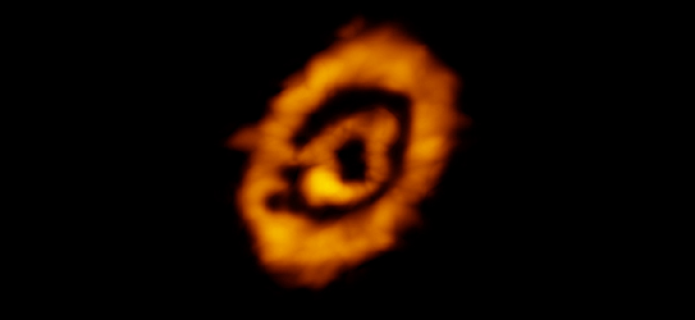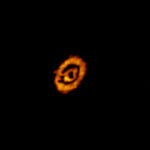Surprising Chemistry Found in Molecular Rings around Young Star
Astronomers using the Atacama Large Millimeter/submillimeter Array (ALMA) have discovered two spectacular rings of molecules encircling the young, Sun-like star IM Lup. The rings are made up of one of the most common heavy ions (charged molecules) in space, DCO+ (deuterium, carbon, oxygen). In this molecule (DCO+), deuterium has replaced the normal hydrogen atom of HCO+ in a process known as hydrogen-deuterium exchange.
This chemistry reveals new insights into the conditions of the planet-forming disk surrounding this young star. "With ALMA we can directly observe this chemistry in disks that are right now in the process of making planets," said Karin Öberg, an astronomer at the Harvard-Smithsonian Center for Astrophysics in Cambridge, Mass., and lead author on a paper published in the Astrophysical Journal. "The molecules have formed two spectacular rings. The inner one we expect to see; the outer one comes as a complete surprise and sheds new light into the properties of a protoplanetary disk's outer reaches."
The presence of a DCO+ ring nearest to the star, the astronomers note, comes from the right combination of low temperatures and abundant carbon monoxide (CO) gas, which is essential for the formation of DCO+. Closer to the star, conditions are too warm for DCO+ to form. Further out, the entire reservoir of CO freezes out, forming a layer of ice on dust grains and planetesimals.

LMA image of dual rings of DCO+ encircling the star IM Lup. The rings reveal details about the conditions of this young protoplanetary disk. The existence of the outer disk was surprising, providing new insights into the formation of heavy molecules -- those based on deuterium -- in this and other similar systems. Credit K. Oberg, CfA; ALMA (NRAO/ESO/NAOJ); B. Saxton (NRAO/AUI/NSF)
The presence of the outer ring implies that farther and farther from the star it not only gets colder and darker, as would be expected, but it also hits a point where the disk density is so low that some light from the host star can penetrate down to the midplane of the disk. This replenishes the reservoir of CO gas and restarts the production of DCO+. Heavy, deuterium-based molecules can thus form in more places around young stars than previously thought.
This increases the utility of these molecules to tell us about the history of both our Solar System and other planetary systems in the making. "Heavy molecules are, in fact, interstellar messengers that tell us how and where different types of molecules form,"noted Öberg. "For example, based on an excess of heavy water in the Earth's ocean we know that most of the Earth's water comes from the pre-Solar nebula, so it's actually older than the Sun!"
The Atacama Large Millimeter/submillimeter Array (ALMA), an international astronomy facility, is a partnership of the European Organisation for Astronomical Research in the Southern Hemisphere (ESO), the U.S. National Science Foundation (NSF) and the National Institutes of Natural Sciences (NINS) of Japan in cooperation with the Republic of Chile. ALMA is funded by ESO on behalf of its Member States, by NSF in cooperation with the National Research Council of Canada (NRC) and the Ministry of Science and Technology (MOST) in Taiwan and by NINS in cooperation with the Academia Sinica (AS) in Taiwan and the Korea Astronomy and Space Science Institute (KASI).
ALMA construction and operations are led by ESO on behalf of its Member States; by the National Radio Astronomy Observatory (NRAO), managed by Associated Universities, Inc. (AUI), on behalf of North America; and by the National Astronomical Observatory of Japan (NAOJ) on behalf of East Asia. The Joint ALMA Observatory (JAO) provides the unified leadership and management of the construction, commissioning and operation of ALMA.
Contacts:
Valeria Foncea
Education and Public Outreach Officer
Joint ALMA Observatory
Santiago, Chile
Tel: +56 2 467 6258
Cell: +56 9 75871963
Email: [email protected]
Charles E. Blue
Public Information Officer
National Radio Astronomy Observatory
Charlottesville, Virginia, USA
Tel: +1 434 296 0314
Cell: +1 434.242.9559
E-mail: [email protected]
Richard Hook
Public Information Officer, ESO
Garching bei München, Germany
Tel: +49 89 3200 6655
Cell: +49 151 1537 3591
Email: [email protected]
Masaaki Hiramatsu
Education and Public Outreach Officer, NAOJ Chile
Observatory
Tokyo, Japan
Tel: +81 422 34 3630
E-mail: [email protected]


